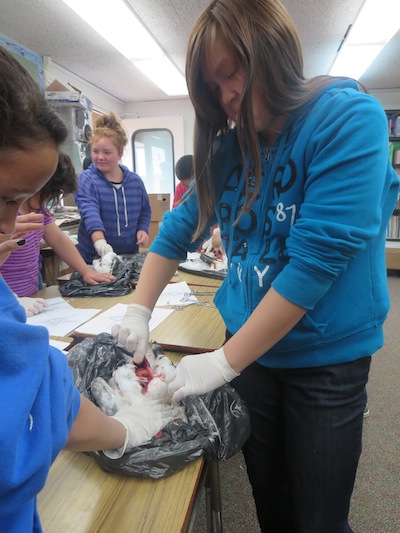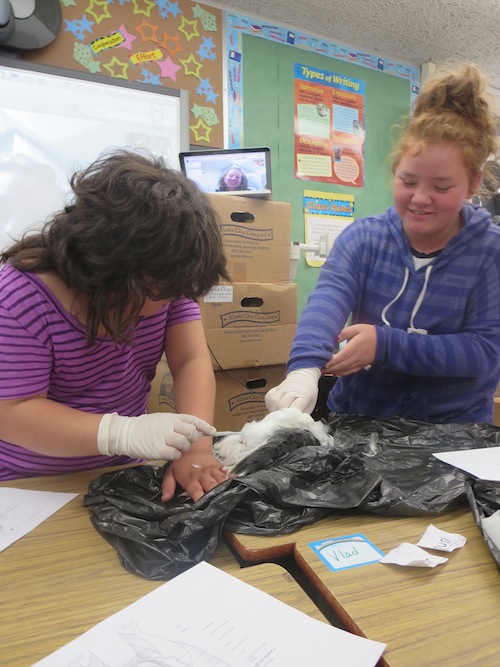 Veronica Padula is a graduate student at UAA (University of Alaska, Anchorage), studying how plastic pollution affects seabirds in Alaska.
Veronica Padula is a graduate student at UAA (University of Alaska, Anchorage), studying how plastic pollution affects seabirds in Alaska.  Veronica has SKYPED with Pribilof students a couple times over the course of last school year, and has been a great resource for us to learn more about marine pollution.
Veronica has SKYPED with Pribilof students a couple times over the course of last school year, and has been a great resource for us to learn more about marine pollution.
Last week, Veronica met with Tonia Kushin’s new 4-6th grade class on St. Paul, and the class was able to follow along with a seabird dissection lesson via SKYPE. Yes, it’s possible!
Here’s Veronica’s report..
I have much to say when it comes to seabirds and pollution, so time often runs short whenever I skype with the students of the Seabird Youth Network. Last week’s lesson with Tonia and the students on St. Paul Island was no different! I was so happy to be asked to talk to another group of students.
 We started by talking about what is made of plastic, and the students pointed to many objects in their own classroom that were composed of plastic. Items like food packaging are often made of plastic, and end up in the trash bin. Sadly, a great deal of this trash ends up in our oceans and is then washed up on distant shorelines. As the students on St. Paul live near the coast, they are familiar with the fact that marine debris often washes up on the shorelines of their very home. But what they are less familiar with is that many wild animals are eating or becoming entangled in that debris.
We started by talking about what is made of plastic, and the students pointed to many objects in their own classroom that were composed of plastic. Items like food packaging are often made of plastic, and end up in the trash bin. Sadly, a great deal of this trash ends up in our oceans and is then washed up on distant shorelines. As the students on St. Paul live near the coast, they are familiar with the fact that marine debris often washes up on the shorelines of their very home. But what they are less familiar with is that many wild animals are eating or becoming entangled in that debris.
This is where I was able to talk to the students about my own research, investigating how plastic pollution is affecting the seabirds of the Aleutian Islands.
Much of my work involves collecting birds and bringing them back to Anchorage for dissection. Kids on St. Paul were lucky enough to get a taste of what bird dissections are like during our Skype lesson because Tonia had received four red-legged kittiwakes from local hunters. I directed the students through all the steps of a dissection, exactly as I would do it in Anchorage. At first I thought it would be difficult to direct the dissections because I was watching them over an internet video feed, but they students did a wonderful job! Some kids seemed a little squeamish first, but I think everyone enjoyed themselves in the end!
Now that Tonia’s class has dissected these birds, these specimens will be sent to my lab in Anchorage to be part of my research!

